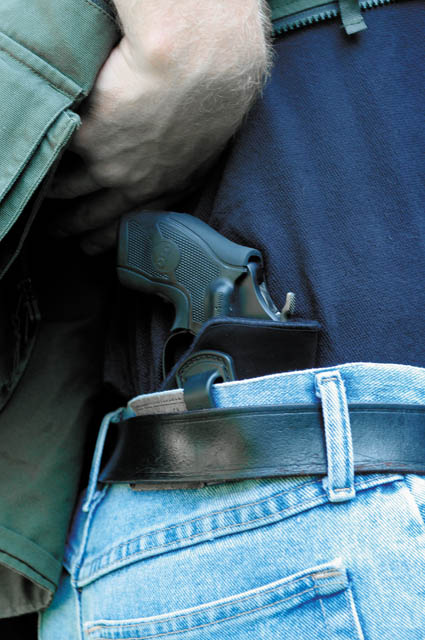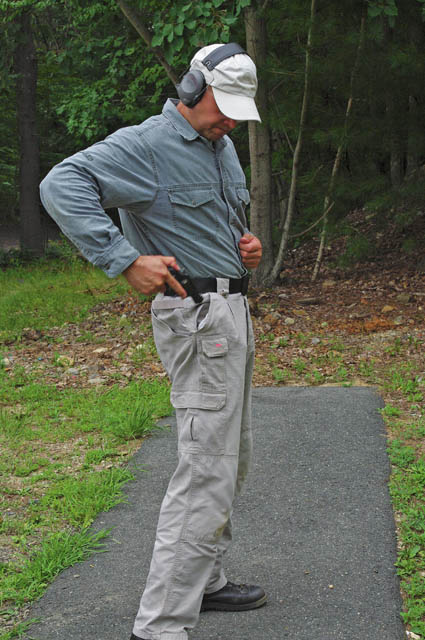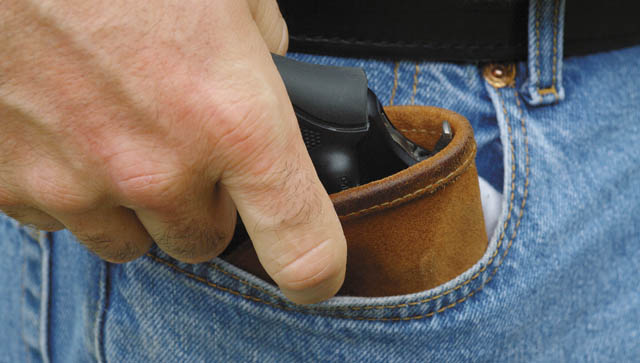
On the ride back from the Rocky Mountain 3-gun match, I shared a rack of miniature airplane seats with two very nice ladies. Both were grandmothers in their late 50s, schoolteachers, liberals and past anti-gun advocates. When conversation came around to my profession, as it always does, I told them I was a gun writer. I used to duck and hide to avoid the hassle, but many years ago I decided I am proud of what I do and will never again apologize for being a gun guy. I figured that would be the end of our conversation—they would do as good liberals on dozens of airplanes have done in the past and frostily turn their backs to me for the duration of the flight.Usually that's fine, but my book on this trip was lousy and I was bored.
Surprisingly, both asked me to help them choose a pistol for personal defense. First, I advised them to get professional training on not only how, but also when, to use their new guns. Then I recommended the same handgun for concealed carry that I have been recommending to first-time gun buyers for as long as they have been asking.
The revolver is about as idiot-proof as a repeating handgun can be, powerful enough with most cartridges to stop bad guys quickly and, at least in one configuration, small and light enough to appeal to anybody making the decision to carry concealed. I told these ladies to buy a Smith & Wesson J-frame revolver. Which one they should choose, I explained, would be determined by their personal needs and budgets.
There are plenty of options, but one of the first decisions any citizen who plans to carry a small-frame revolver is the most important—do you go with a double-action model having an exposed hammer or a double-action-only gun that has a fully enclosed, internal hammer?
When I was attending the IDPA Indoor Championship match at Smith & Wesson last winter, I spent some time checking out the company's retail shop and looking over the options for a replacement for my Model 36. It didn't take long to decide I wanted the M&P360 with an exposed hammer, a scandium-alloy frame and an XS Sight Systems 24/7 Big Dot Tritium front-sight bead. Or so I thought.
I usually prefer a J-frame with an external hammer. The M&P360 would be more than just an urban defensive handgun for me, as I would also carry the gun in the field while hunting, fishing and hiking. For this type of use, I really like the exposed hammer so I can access the single-action trigger pull for more precise shooting at extended distances. But, conventional wisdom has always been the hammerless double-action-only J-frame is a better carry gun because there is no exposed hammer to snag during the draw.
I was at an impasse, especially since Smith & Wesson makes an M&P340 that has the same features as the M&P360, only with an internal hammer. This led to an idea for a test, so I ordered both guns. My plan was to run timed drills with both designs to see if the hammer would be an issue during presentation.
There was one thing I was sure of: No matter which gun I decided to keep for carry, it would have a set of Crimson Trace Lasergrips. That's one piece of advice I have added to the recommendations I give to first-time gun buyers concerned about self-defense.
Having a laser sight on a small-frame revolver changes the shootability of the gun. The short sight radius of a 2-inch-barreled revolver doesn't make it easy for anybody to shoot. But, a laser makes the gun essentially no more difficult to shoot—or at least to aim accurately—than any other revolver. Beyond that, a laser sight allows you to keep your eyes on the bad guy and lasers work in the dark, where you can't see your sights.
Smith & Wesson offers the double-action-only M&P340 as a "CT" model, meaning the gun comes with Lasergrips installed. The M&P360 is not available from the factory with Lasergrips, so I added them after the gun arrived. Both guns were tested with .38 Spl. ammo, although they are chambered for .357 Mag.
I contacted Blackhawk and ordered left- and right-handed models of four common styles of carry holsters: belt-mounted, inside-the-waistband (IWB), pocket and ankle. Then I went looking for some volunteers to help with the test. I found them at the Nenameseck Sportsmen's Club in Palmer, MA.
I have attended a couple of the club's matches recently and made some new friends. Chris Klassanos, Eric Phinney, John Schrijn, Matthew Nash and Brian Chisholm are all excellent shooters with experience in competition. They agreed to help conduct the test.
Each shooter was instructed to draw and fire one double-action shot at an IDPA target placed at 7 yards. Only hits counted for time. We repeated this at least five times with each gun in each holster. Not everyone shot using every combination, but I made sure each shooter used both revolvers with the same holster. I requested each shooter wear a concealment garment, usually a vest, with the appropriate holsters, as they would on the street. The data was combined with the results I conducted on my home range, following the same parameters.
The exposed-hammer M&P360 actually averaged 0.12 second faster than the hammerless M&P340 when drawing from the Blackhawk belt holster, and nobody reported any problems related to the external hammer. The belt holster was, of course, everybody's favorite design, and it's one of the most-popular holster types for concealed carry. Nonetheless, it came in second for speed, with an average of 1.65 seconds required to draw and shoot either gun. However, most of the shooters started the test with this holster, so I suspect the slightly slower times were partly due to becoming more proficient as our experiment progressed.
It was a similar story with the IWB holster. The shooters had slightly faster times with the M&P360. Once again, no one reported any problems related to the exposed hammer, which was a surprise. The only issue a few shooters experienced was, with the gun being tucked so tight to their bodies, their shirts sometimes got in the way and they grabbed fabric with the gun. But, that happened with both revolvers. The shooters had faster average times with both guns when using the IWB holster compared to the belt holster, which came as another surprise. Sweeping the vest back and drawing from a holster is something they all do in every IDPA match, but I expected to see higher times with the IWB holster simply because the gun is not as easy to access due to its position. Given the times we recorded, I don't see a tactical disadvantage to this holster.
The idea of this test was to see if an exposed hammer causes a problem during presentation, and I figured the pocket holster is where the issue would rear its ugly head. I was correct in my assessment.
We tested the guns in the pocket holster two ways: with the shooters' hands hanging by their sides and with their strong-side hands inside the pocket gripping the gun. I also added a Galco pocket holster that one of the shooters used for his personal carry gun. There was no appreciable difference between the two brands of holster in terms of times.
It was pretty amazing to see how fast you can draw from a holster in your front pants pocket when you start with your hand in the pocket and on the gun. The average time for all the shooters using this method with the M&P360 was .85 seconds from buzzer to shot. The fastest shooter averaged .66 seconds. Remember, only shots that hit the target counted. The average time when the shooters started with their hands outside of the pocket was 2.62 seconds—a big difference. Times for this part of the test were all over the place, depending on the gun and type of pants. The slowest was 4.32 seconds versus the fastest (mine) of 1.6 seconds.
I found the pocket holster shrouded the external hammer during part of the draw and kept it from snagging. The only consistent problem was with the deep front pockets on a popular brand of tactical pants worn by one of the shooters. In that situation, the holster and revolver sat very low, and the gun had to travel several inches inside the pocket after leaving the protection of the holster. More often than not, the M&P360's hammer snagged on the pocket and delayed the draw. In most blue jeans and other brands of tactical pants, this was not a problem. The key is loose-fitting pants with shallow pockets. The hammerless M&P340, of course, had no issues with snagging when drawn from the pocket holster.
The average ankle holster draw time while wearing long pants and starting from a standing position came in at 2.54 seconds—not bad considering how difficult it is to get to the holster. I must note the ankle holster's retention system did not play well with the hammerless gun, as it was designed for an exposed hammer. To make it fair, we removed the retention system so both guns had an even playing field. But, I would never carry a revolver in an ankle holster without retention, so the times are a bit skewed from what they would be on the street.
When the guns were drawn from the pocket without a holster, the hammer again became a problem. It snagged on the pocket fabric half the time. I think this would be an issue regardless of whether the gun was in a pants or a jacket pocket. But carrying a gun in your pocket without a holster isn't a particularly good approach anyway, as the revolver will not stay correctly oriented for the draw. When you have to draw quickly, it will never be in the right place. During the test, getting the gun turned around and into action sometimes took a very long time.
So which of these revolvers will I keep for carry? The choice comes down to versatility. I'll still pick the exposed-hammer M&P360 because of field use—I like the ability to choose a single-action trigger pull for the reasons stated earlier. But I'll certainly avoid carrying it in a pocket holster.
The test proved an external hammer can—and does—snag on your clothing during the draw. Even once is too often if you are fighting for your life. Were I buying a revolver purely as a defensive handgun and not considering sporting use, I would go with the DAO M&P340.







































